Steven Patrick, Patricia M. Dorman and Robert L. Marsh (1999)
Journal of Artificial Societies and Social Simulation vol. 2, no. 1, <https://www.jasss.org/2/1/1.html>
To cite articles published in the Journal of Artificial Societies and Social Simulation, please reference the above information and include paragraph numbers if necessary
Received: 20-Dec-98 Accepted: 1-Jan-99 Published: 31-Jan-99
![]()
 Abstract
Abstract| A | COER.K=TABHL(CTAB,COMPLY.K,-1,1,.2) |
| COMPLY -1 -.8, -.6, -.4, -.2, 0, .2, .4, .6, .8, 1.0 | |
| T | CTAB=.4,.3,.3,.3,.2,.2,.2,.2,.1,.05,-.1 |
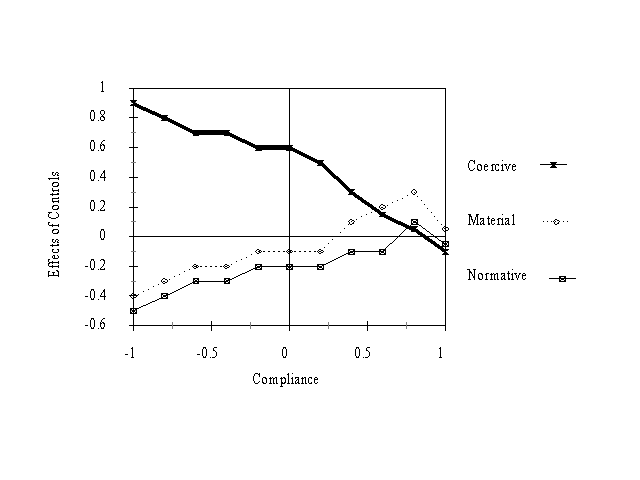 |
| Figure 1: The Relationship between Compliance and the Control Processes |
| A | MAT.K=TABHL(MTAB,COMPLY.K,-1,1,.2) | |
| COMPLY -1.0 -.8, -.6, -.4, -.2, 0, .2, .4, .6, .8, 1.0 | ||
| T | MTAB=-.4,-.3,-.2,-.15,-.1,-.05,.1,.2,.25,.15,.05 | |
| A | NOR.K=TABHL(NTAB,COMPLY.K,-1,1,.2) | |
| COMPLY -1.0 -.8, -.6, -.4, -.2, 0, .2, .4, .6, .8, 1.0 | ||
| T | NTAB=-.35,-.3,-.25,-.2,-.15,-.1,-.1,.05,.1,-.05,-.1 | |
| Table 1: Dynamo Equation Types and Functions used in this Paper |
| Equations |
| L = Level |
| R = Rate |
| A = Auxiliary |
| C = Constant |
| N = Initial Value |
| T = Table |
| Functions |
| Min = Minimum Value |
| Max = Maximum Value |
| Delay = Use Value from Future Calculation |
| L | COMPLY.K=COMPLY.J+DT*((COERCIVE.JK*COER.J)+ |
| (MATERIAL.JK*MAT.J)+(delay1(NORM.J,1)*NOR.J)) | |
| N | COMPLY=.1 |
| R | COERCIVE.KL=max(((((COMPly.K*-.43)-(descomp.k*.09))+ |
| (TASKTYP.K*.58)+(STRUCTU.K*.53)+(DELAY1(CONFLICT.K,1)*.57)+ | |
| (NORM.K*-.43)+(MATERIAL.KL*.23))*(ORGRES*-.5)),0) | |
| N | COERCIVE=.1 |
| R | MATERIAL.KL=((COMPly.K*.73)-(descomp.k*.1))+ |
| (TASKTYP.K*-.74)+(STRUCTU.K*-.66)+(CONFLICT.K*.14) | |
| +(RCON.K*.1)+(NORM.K*.76)+ | |
| (DELAY1(COERCIVE.KL,1)*.14)* (ORGRES*.75) | |
| N | MATERIAL=.1 |
| L | NORM.K=NORM.J+DT*(((COMPly.J*.1)-(descomp.j*.11))+ |
| (TASKTYP.J*.04)+(STRUCTU.J*.21)+(CONFLICT.J*.24)+ | |
| (NORDIF.J*.11)+(MATERIAL.JK*.1)+(COERCIVE.JK*.24))* | |
| (ORGRES*.26) | |
| N | NORM=.1 |
| A | DESCOMP.K=(DC*.2)*(STRUCTU.K*.2) |
| C | DC=.1 |
| A | RCON.K=(DELAY1(MATERIAL.KL,1)*.2)*(TASKTYP.K*.11) |
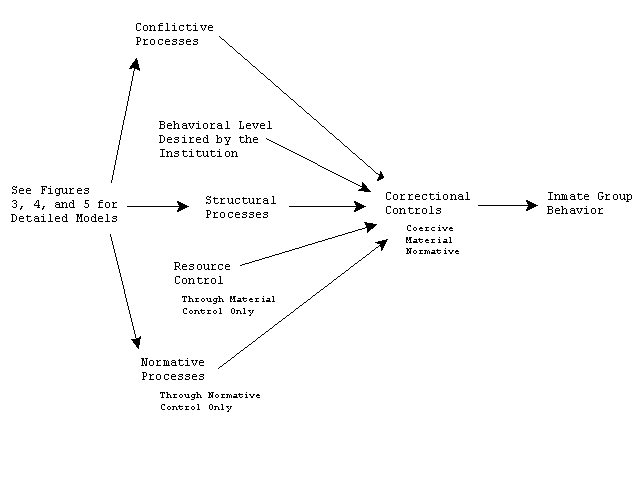 |
| Figure 2: Simplified Path Model of Inmate Group Behavior (Nonrecursive and duplicate paths not shown to reduce visual complexity) |
| A | CONFLICT.K=((ALIEN.K*.35)+(COORD.K*-.21))*(NEGO.K*.4) |
| N | CONFLICT=.1 |
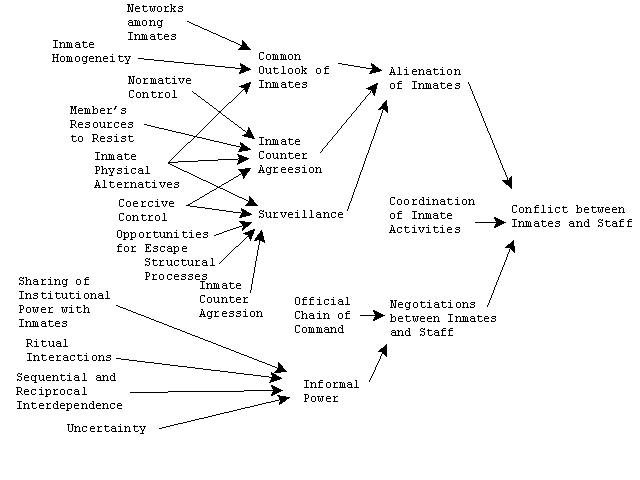 |
| Figure 3: Simplified Path Model for Conflictive Processes (Nonrecursive and duplicate paths not shown to reduce visual complexity) |
| A | ALIEN.K=((COMMON.K*.18)*(DELAY1(SURVEIL.KL,1)*.17))+ |
| (COUNTAG.K*.17) | |
| N | ALIEN=.1 |
| A | NEGO.K=((POWER.K*.11)*(CHAIN.K*.2)) |
| A | COMMON.K=(NETWORK.K*.15)+(PHYALT.K*.15)+(HOMO*.1) |
| A | NETWORK.K=(FRIEND.K*-.33)+(INFORG.K*.65)+(DEP.K*.36) |
| C | HOMO=.3 |
| L | PHYALT.K=PHYALT.J+DT*((STRUCTU.J*-.15)*(GEO*.24)) |
| N | PHYALT=.1 |
| A | COUNTAG.K=(DELAY1(COERCIVE.KL,1)*.91)+(MEMRES*.86)+ (NORM.K*-.96)+(PHYALT.K*-.73)+(COMMON.K*.85) |
| N | COUNTAG=.1 |
| C | MEMRES=.1 |
| R | SURVEIL.KL=((CHAIN.K*.37)+(ESCAPE.K*-.24)+ |
| ((DELAY1(COERCIVE.KL,1)*-.18)+(PHYALT.K*.14)+ | |
| (COUNTAG.K*.28))*(STRUCTU.K*.25)) | |
| N | SURVEIL=.1 |
| A | ESCAPE.K=(DELAY1(COERCIVE.KL,1)*.17)+(MEMRES*-.06)+ |
| (NORM.K*.03)+(DELAY1(SURVEIL.KL,1)*-.10)+(PHYALT.K*.17) | |
| A | POWER.K=((SINTER.K*.84)+(RINTER.K*-.43)+(PHYALT.K*.4)+ |
| (GEO*.25)+(UNCERT*.53)+(SHARE.K*.31)+(RITUALS.K*.16)) | |
| A | SINTER.K=((CHAIN.K*.04)+(PHYALT.K*.02))*(TASKTYP.K*.24) |
| A | DEP.K=(SINTER.K*-.09)-(RINTER.K*.14) |
| C | UNCERT=.1 |
| A | STRUCTU.K=((UNCERT*-.17)+(COORD.K*.17)+ |
| (COUPLE.K*.26))* (ENVIRON.K*-.03) | |
| N | STRUCTU=.1 |
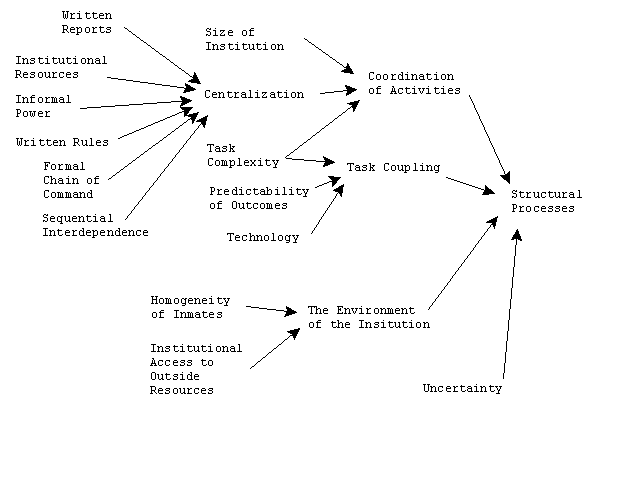 |
| Figure 4: Simplified Path Model of Structural Processes (Nonrecursive and duplicate paths not shown to reduce visual complexity) |
| A | ENVIRON.K=(TECH*.43)+(HOMO*.08)+(OUT*.02) |
| C | OUT=.1 |
| A | COUPLE.K=(TASKTYP.K*.44)+(UNCERT*.8) |
| A | TASKTYP.K=(UNCERT*-.51)*(TECH*-.44)*(OUTPRED.Kl*.02) |
| N | TASKTYP=.1 |
| C | TECH=.1 |
| R | OUTPRED.KL=(PHYALT.K*-.21)*(TECH*.41) |
| A | COORD.K=((SIZE*.22)+(CENTRAL.K*.11))*(TASKTYP.K*.09) |
| C | SIZE=.3 |
| L | CENTRAL.K=CENTRAL.J+DT*(((ENVIRON.J*-.2)+(WRITRULE.J*.88)+ |
| (POWER.J*-.27)+(SINTER.J*.88)+(WRITREP.J*.9))*(ORGRES*-.73)) | |
| N | CENTRAL=.6 |
| A | WRITREP.K=((CENTRAL.K*.62))*(OUTPRED.KL*.31) |
| L | WRITRULE.K=WRITRULE.J+DT*(((PHYALT.J*.16)+ |
| (UNCERT*-.45))* (STRUCTU.J*.27)) | |
| N | WRITRULE=WR |
| C | WR=.3 |
| C | ORGRES=.3 |
| A | NORDIF.K=(SHARE.K*.15)+((RITUALS.K*.15)-(SHARE.K*.15)) |
| A | SHARE.K=((PROMO*.45)+(DEF*-.13)+ |
| (GIVORDS.K*-.12))* (COORD.K*.32) | |
| A | RITUALS.K=(ISOLATE*.19)+(CONDIT.K*.12)+ |
| (DELAY1(FRIEND.K,1)*.12) | |
| N | RITUALS=.1 |
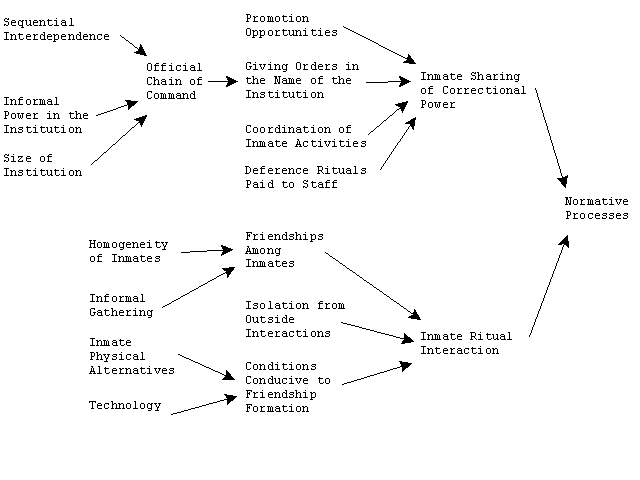 |
| Figure 5: Simplified Path Model for Normative Processes (Nonrecursive and duplicate paths not shown to reduce visual complexity) |
| C | PROMO=.1 |
| C | DEF=.6 |
| A | GIVORDS.K=(CHAIN.K*.22)+(PROMO*.13) |
| L | CHAIN.K=CHAIN.J+DT*((WRITRULE.J*.31)+ |
| (POWER.J*.06)+ (SIZE*.24)+(SINTER.J*.04)) | |
| N | CHAIN=.3 |
| A | FRIEND.K=((INFORG.K*.24)+(RITUALS.K*.19))*(HOMO*.17) |
| N | FRIEND=.1 |
| C | ISOLATE=.6 |
| A | INFORG.K=(CONDIT.K*.61)*(TASKTYP.K*.17) |
| A | CONDIT.K=(PHYALT.K*.27)*(TECH*.07) |
| N | CONDIT=.1 |
| C | GEO=.1 |
| Table 2: Variables within the Model | |
| COMPLY | Compliance of organizational members |
| DESCOMP | Desired level of compliance |
| COERCIVE | Organizational coercion |
| MATERIAL | Organizational use of material rewards |
| RESCON | Control of resources by the organization's members |
| NORM | Normative control in the organization |
| TASKTYP | Task type |
| *TECH | Technological production |
| STRUCTUR | Structuring processes in the organization |
| *UNCERT | Uncertainty in the organization |
| COORD | Coordination processes within the organization |
| CENTRAL | Centralization |
| COUPLE | Complexity of the task coupling in the organization |
| ENVIRON | Environment of the organization |
| *HOMO | Homogeneity of the environment |
| *OUT | Resource base outside the organization |
| CONFLICT | Conflict over control within the organization |
| ALIEN | Member's alienation |
| SURVEIL | Surveillance conducted by the organization |
| COMMON | Member's common outlook |
| NETWORK | Networks within the organization |
| DEP | Members mutual dependency |
| NORDIF | Normative difference between the sharing of power and rituals |
| SHARE | Sharing of power within the organization |
| RITUAL | Rituals within the organization |
| *ORGRES | Organizational resources |
| OUTPRED | Outcome predictability |
| WRITRULE | Written rules |
| CHAIN | Chain of command of the organization |
| PHYSALT | Physical alternatives of the organization |
| *GEO | Geographic dispersion of the organization in physical space |
| ESCAPE | Members escape |
| COUNTAG | Members counter aggression |
| *MEMRES | Member's resources |
| POWER | Power within the organization |
| NEGO | Negotiations within the organization |
| FRIEND | Friendships within the organization |
| WRITREP | Written reports |
| *SIZE | Organizational size |
| SINTER | Sequential interdependence |
| RINTER | Reciprocal interdependence |
| *PROMO | Members promotions |
| *DEF | Deference rituals paid by lower members to higher members |
| GIVORD | Members giving orders in the name of the organization |
| CONDIT | Conditions conducive to friendships |
| *ISOLATE | Isolation of members from the outside |
| INFORM | Informal gatherings |
 |
| Figure 6: Behavior and Control Patterns Over 750 Simulation Time Points |
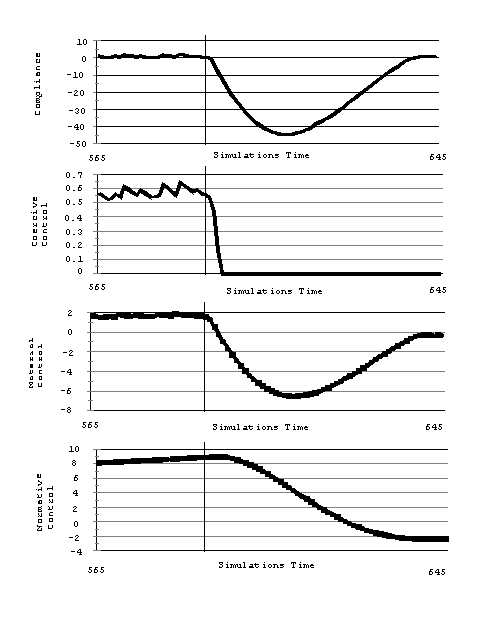 |
| Figure 7: Behavior and Control Patterns for Noncompliance Episode |
2In this theory organizations are divided, by dominant type of control used, into coercive, material, and normative. All organizations use all type of control but one will be dominant. Each type of organization requires a different minimal level of compliance from members. Coercive organizations, due to their conflictive nature, require the lowest level of minimal compliance. I prisons for example inmates are expected only to follow given orders to the letter and then only in the presents of coercive agents. Material organizations require higher minimal levels in that members are expected to follow written rules without direct supervision. Normative organizations required the highest minimal compliance in that members are expected to be self regulated and act in the best interests of the organization.
3Inmates are the organizational members whose compliance is of interest here. This same model could be applied to guards or other organizational members but the behavior of inmates is of key interest here. Other organizational members are seen as parts of the control process itself. Administrators set rules and guard enforce them.
4It should be noted that the use of constants for these eleven variables is empirically unrealistic. The constants are used initially to analyze this model. With the collection of organizationally specific data, it would be possible to introduce variation into these external variables based on changes in the model. As discussed below, this model produces more frequent periods of negative inmate group behavior than observed in the environment. Often, periods of inmate behavioral instability, such as overcrowding, are observed and can be quickly reduced or the organization can receive a sudden influx of extra resources. Future analysis will incorporate these variations, but for this first application it illustrates more to hold them constant and see what the model produces.
5Normative controls are the most difficult to obtain in any organization. The fact that they are so high in this simulation may be because of the organizational data, mostly from material organizations, that is used to parameterize the model. When correctional data is gather we will be able to determine if this is the result of problems in the model or in the data.
BAROW, Agnes. 1994. "Political Culture and Staff Violence: The Case of Hawaii's Prison System." in M. Braswell, R. Montgomary jr, and L. Lombardo. eds. Prison Violence in America. 2ed ed. 123-144. Cincinnati: OH. Anderson Publishing.
BERK, B. 1966. "Organizational Goals and Inmate Organization." American Journal of Sociology. Vol 71:522-534.
COLLINS, Randall. 1988. Theoretical Sociology. New York: Harcourt, Brace and Jovanovich.
CROZIER, Michael. 1964. The Bureaucratic Phenomenon. Chicago: University of Chicago Press.
CUVELIER, Steven Jay. 1991. "Computer Simulation Applications in Jail Research." In G. Larry Mays (ed.), Setting the Jail Research Agenda for the 1990s, pp. 44-52. Washington D.C.: National Institute of Corrections.
ETZIONI, Amitai. 1975. A Comparative Analysis of Complex Organizations. New York: Free Press.
FLEISHER, Mark. 1989. Warehousing Violence. Beverly Hills: Sage.
FORESTER, John. 1967. "General Systems Theory."
FOX, V. 1972. "Prison Riots in a Democratic Society." Police Vol. 26, No. 12, pp. 25-42. GURR, T.R. 1972. "Psychological Factors in Civil Violence." In I.K. Feierabend, R.L. Feiarabend, and T.R. Gurr (eds.) Anger, Violence, and Police. Monterey. CA: Brooks/Cole.
HAMM, Mark, Therese Coupez, Frances Hoze, and Corey Weinstein. 1994. "The Myth of Humane Imprisonment: A Critical Analysis of Severe Discipline in U.S. Maximum Security Prisons, 1945-1990." in M. Braswell, R. Montgomary jr, and L. Lombardo. eds. Prison Violence in America. 2 ed. 167-200. Cincinnati: OH. Anderson Publishing.
HANNEMAN. Robert. 1988. Computer Aided Theory Construction. Beverly Hills: Sage.
HANNAN, Michael and John Freeman. 1977. "The Population Ecology of Organizations." American Journal of Sociology. Vol 82: 929-940.
HUNTER, John and Frank Schmidt. 1980. Meta-Analysis. Beverly Hills: Sage.
IRWIN, J. 1980. Prisons in Turmoil. Boston: Little Brown.
JOHNSON, R. 1987. Hardtimes: Understanding and Reforming the Prison. Monterey, CA: Brooks and Cole.
LOMBARDO, Lucien. 1994. "Stress, Change and Collective Violence in Prison." in M. Braswell, R. Montgomary jr, and L. Lombardo. eds. Prison Violence in America. 2 ed. 291-305. Cincinnati: OH. Anderson Publishing.
LIGHT, Stephen. 1991. "Assaults on Prison Officers: International Themes." Justice Quarterly. Vol 8(2) 243-261.
MAHAN, S. 1985. "An 'Orgy of Brutality' at Attica and the 'Killing Ground' at Santa Fe." In M. Braswell, S. Dillingham, and R. Montgomery, Jr (ed), Prison Violence in America. Cincinnati: Anderson, pp. 73-78.
MAHAN, Sue. 1994 "An Orgy of Brutality at Attica and the Killing Ground at Santa Fe: A Comparison of Prison Riots" in M. Braswell, R. Montgomary jr, and L. Lombardo. eds. Prison Violence in America. 2 ed. 253-264. Cincinnati: OH. Anderson Publishing.
MARQUART, J. and B. Crouch. 1994. "Judicial Reform and Prison control: The Impact of Ruiz vs Estellean on Texas Penitentiary." in M. Braswell, R. Montgomary jr, and L. Lombardo. eds. Prison Violence in America. 2 ed. 265-290. Cincinnati: OH. Anderson Publishing.
MARTIN, Randy and Sherwood Zimmerman. 1990 "A Typology of the Causes of Prison Riots and an Analytical Extension to the 1986 West Virginia Riot." Justice Quarterly. Vol 7(4) 711-737.
McWhorten, W. L. 1981. Inmate Society: Legs, Halfpants and Gunmen: A Study of Inmate Guards. Saratoga, CA: Century Twenty One Publishing.
MONTGOMERY, Reid, Jr. 1994. "American Prison Riots: 1774-1991." in M. Braswell, R. Montgomary jr, and L. Lombardo. eds. Prison Violence in America. 2 ed. 227-251. Cincinnati: OH. Anderson Publishing.
OUCHI, William. 1977. "Organizational Structure and Organizational Control." Administrative Science Quarterly. Vol 22 pp 95-121.
PATRICK, Steven. 1991. "Organizational Control." Unpublished Doctoral Dissertation. University of California, Riverside.
PATRICK, Steven. 1993. "Linking Empirical Data To Continuous-Time, Continuous State Computer Simulation." Social Science Computer Review, 11:1, 33-47.
PATRICK, Steven. 1995. "Simulating Control Processes in Material Organizations." Sociological Perspectives, 38:4. 498-520.
PERROW, Charles. 1967. "A Framework for the Comparative Analysis of Organizations." American Sociological Review. Vol32. pp 194-208.
PERROW, Charles. 1984. Normal Accidents. New York: Basic Books
RICHARDSON, G. and Pugh, A.. 1986. Introduction to Systems Dynamics Modeling with Dynamo. Cambridge: MIT Press.
SCHARF, Peter. 1983. "Empty Bars: Violence and the Crisis of Meaning in Prison." Prison Journal, Vol 63(1) 114-124.
SIMON, Herbert, 1976, Administrative Behavior: A Study of Decision-Making Processes in Administrative Organization, New York: The Free Press.
TOCH, Hans. 1985. "Social Climate and Prison Violence." in M. Braswell, S. Dilingham and R. Montgomery jr. Eds. Prison Violence in America. pp 37-46. Cincinnati, OH: Anderson Publishing.
TOCH, Hans. 1994. "Violence from Without and Within: Safety." in M. Braswell, R. Montgomary jr, and L. Lombardo. eds. Prison Violence in America. 2 ed. 11-26. Cincinnati: OH. Anderson Publishing.
WEBER, Max. 1922/1968. Economy and Society. New York: Bedminster Press.
WHEELER, S. B. 1961. "Socialization in Correctional Communities." American Sociological Review. Vol 26: 697-712.
WRIGHT, Kevin. 1991. "The Violent and Victimized in the Male Prison." Journal of Offender Rehabilitation. Vol 16(3/4): 258-274.
Return to Contents of this issue
© Copyright Journal of Artificial Societies and Social Simulation, 1998